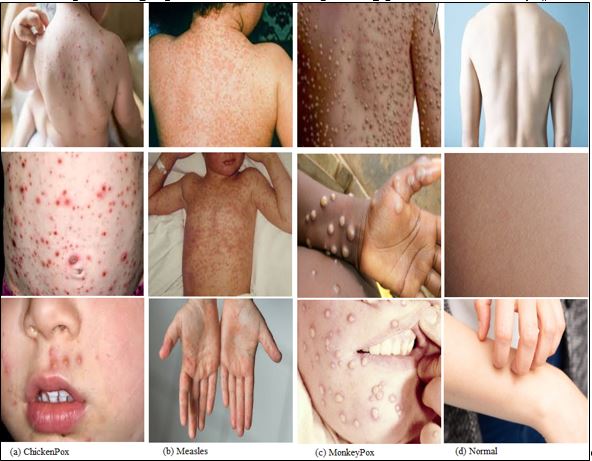Deep Learning for Viral Detection: Affordable Camera Technology in Public Health
Keywords:
Deep Learning, Contagious Infections, Mobile Net Architecture, Infection Diagnosis, Image ClassificationAbstract
Viral infections like chickenpox, measles, and monkeypox pose significant global health challenges, affecting millions with varying severity. This study presents a novel deep learning approach using widely available low-cost RGB camera technology to accurately identify these infections based on skin manifestations. Our aim is to enhance diagnostic capabilities and enable timely interventions, thus improving public health outcomes and individual well-being. Using MobileNetV3 for data classification, our model achieved a precision of 95% for positive cases, an overall accuracy of 95.73%, a recall of 88.37%, and an F1-score of 91.56%, indicating balanced performance between precision and recall. Notably, the model demonstrated exceptionally high specificity at 98.34%, effectively identifying negative cases. This deep learning approach holds promise for improving diagnostic accuracy and efficiency, especially in resource-limited settings with limited access to specialized medical expertise. By leveraging low-cost RGB camera technology, our method enables broad deployment, facilitating early detection and treatment of viral infections. We focus on the potential of deep learning in public health by emphasizing the critical role of early detection and intervention in mitigating the impact of viral infections. Our findings contribute to advancing healthcare technology and lay the groundwork for future innovations in disease detection and management.
References
A. Majeed et al., “Patterns of Common Dermatological Conditions among Children and Adolescents in Pakistan,” Medicina (Kaunas)., vol. 59, no. 11, Nov. 2023, doi: 10.3390/MEDICINA59111905.
H. Najeeb and Z. Huda, “Monkeypox virus: A spreading threat for Pakistan?,” Ann. Med. Surg., vol. 79, p. 103977, Jul. 2022, doi: 10.1016/J.AMSU.2022.103977.
M. O. Mere et al., “Progress Toward Measles Elimination — Pakistan, 2000–2018,” MMWR. Morb. Mortal. Wkly. Rep., vol. 68, no. 22, pp. 505–510, Jun. 2019, doi: 10.15585/MMWR.MM6822A4.
B. Ram Sahu, A. Kumar Shrivas, and A. Shukla, “Skin Disease Classification using Machine Learning based Proposed Ensemble Model,” 2023 4th Int. Conf. Emerg. Technol. INCET 2023, 2023, doi: 10.1109/INCET57972.2023.10170128.
P. Banditsingha, T. Thaipisutikul, T. K. Shih, and C. Y. Lin, “A Decision Machine Learning Support System for Human Skin Disease Classifier,” 7th Int. Conf. Digit. Arts, Media Technol. DAMT 2022 5th ECTI North. Sect. Conf. Electr. Electron. Comput. Telecommun. Eng. NCON 2022, pp. 200–204, 2022, doi: 10.1109/ECTIDAMTNCON53731.2022.9720379.
R. K. Hapsari, E. Purwanti, W. Widyanto, R. Gunawan, F. Nurlaily, and A. H. Salim, “Optimization Based Random Forest Algorithm Modification for Detecting Monkeypox Disease,” 2023 6th Int. Conf. Vocat. Educ. Electr. Eng. Integr. Scalable Digit. Connect. Intell. Syst. Green Technol. Educ. Sustain. Community Dev. ICVEE 2023 - Proceeding, pp. 340–346, 2023, doi: 10.1109/ICVEE59738.2023.10348223.
A. Mir, A. U. Rehman, S. Javaid, and T. M. Ali, “An Intelligent Technique for the Effective Prediction of Monkeypox Outbreak,” 3rd IEEE Int. Conf. Artif. Intell. ICAI 2023, pp. 220–226, 2023, doi: 10.1109/ICAI58407.2023.10136662.
S. Pal, A. K. Mishra, and Kriti, “Artificial Intelligence-Based Framework for Predicting Monkeypox Disease,” 2023 Int. Conf. Comput. Sci. Emerg. Technol. CSET 2023, 2023, doi: 10.1109/CSET58993.2023.10346841.
M. E. Haque, M. R. Ahmed, R. S. Nila, and S. Islam, “Human Monkeypox Disease Detection Using Deep Learning and Attention Mechanisms,” Proc. 2022 25th Int. Conf. Comput. Inf. Technol. ICCIT 2022, pp. 1069–1073, 2022, doi: 10.1109/ICCIT57492.2022.10055870.
M. Pal et al., “Deep and Transfer Learning Approaches for Automated Early Detection of Monkeypox (Mpox) Alongside Other Similar Skin Lesions and Their Classification,” ACS Omega, vol. 8, no. 35, pp. 31747–31757, Sep. 2023, doi: 10.1021/ACSOMEGA.3C02784/ASSET/IMAGES/LARGE/AO3C02784_0005.JPEG.
N. Nazmee, M. S. Ali, S. Mahmud, K. Alam, A. Chakrabarty, and M. Fahim-Ul-Islam, “Enhancing Monkeypox Diagnosis: A Machine Learning Approach for Skin Lesion Classification,” 2023 26th Int. Conf. Comput. Inf. Technol. ICCIT 2023, 2023, doi: 10.1109/ICCIT60459.2023.10441041.
Z. Wu et al., “Studies on Different CNN Algorithms for Face Skin Disease Classification Based on Clinical Images,” IEEE Access, vol. 7, pp. 66505–66511, 2019, doi: 10.1109/ACCESS.2019.2918221.
E. Goceri, “Analysis of Deep Networks with Residual Blocks and Different Activation Functions: Classification of Skin Diseases,” 2019 9th Int. Conf. Image Process. Theory, Tools Appl. IPTA 2019, Nov. 2019, doi: 10.1109/IPTA.2019.8936083.
A. Afroz, R. Zia, S. Noor, A. O. Garcia, S. Shams, and S. Mughal, “Implementation of Convolutional Neural Networks deep learning approach to Classify Melanoma Skin Cancer,” 2023 Glob. Conf. Wirel. Opt. Technol. GCWOT 2023, 2023, doi: 10.1109/GCWOT57803.2023.10064671.
P. B. Manoorkar, D. K. Kamat, and P. M. Patil, “Analysis and classification of human skin diseases,” Int. Conf. Autom. Control Dyn. Optim. Tech. ICACDOT 2016, pp. 1067–1071, Mar. 2017, doi: 10.1109/ICACDOT.2016.7877750.
A. Pramanik, S. Sultana, and M. S. Rahman, “Time Series Analysis and Forecasting of Monkeypox Disease Using ARIMA and SARIMA Model,” 2022 13th Int. Conf. Comput. Commun. Netw. Technol. ICCCNT 2022, 2022, doi: 10.1109/ICCCNT54827.2022.9984345.
A. Howard et al., “Searching for MobileNetV3,” Proc. IEEE Int. Conf. Comput. Vis., vol. 2019-October, pp. 1314–1324, May 2019, doi: 10.1109/ICCV.2019.00140.
D. Bala et al., “MonkeyNet: A robust deep convolutional neural network for monkeypox disease detection and classification,” Neural Networks, vol. 161, pp. 757–775, Apr. 2023, doi: 10.1016/j.neunet.2023.02.022.

Downloads
Published
How to Cite
Issue
Section
License
Copyright (c) 2024 50SEA

This work is licensed under a Creative Commons Attribution 4.0 International License.




















